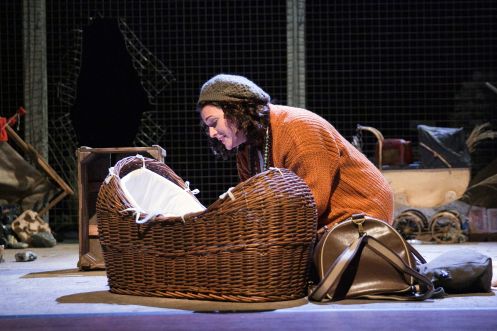My Mother Said I Never Should
Love, Jealousy, and the Price of Freedom
My Mother Said I Never Should
by Charlotte Keatley
London Classic Theatre at Richmond Theatre until 2nd March, then tour continues until 20th April
A Review by Andrew Lawston
A rubble-strewn wasteland litters Richmond Theatre’s stage. Part bombsite, part derelict factory, part suburban living room. There’s even a bare tree with a laced pair of trainers dangling from the upper branches as though JD Sports were sponsoring Waiting For Godot.
But instead of two tramps adrift in time and space, four young girls come poking through the rubble to play, in wildly disparate costumes. Charlotte Keatley’s My Mother Said I Never Should starts with intensity and never lets up in Michael Cabot’s new touring production.

The quartet of characters span several generations and most of the Twentieth Century: Doris, Margaret, Jackie, and Rosie live their lives as society’s opportunities and expectations for women evolve dramatically, while quietly demonstrating that women have always wanted more than just to get married young and have children quietly.
Judith Paris’s Doris initially seems to be a fearsome and detached matriarch when raising her reluctant pianist daughter Margaret. She seems much more comfortable twenty years or so later when looking after her granddaughter Jackie, and later she is positively complicit in great-granddaughter Rosie’s games and nascent activism, revealing an inherent non-conformist streak that had been suppressed all along. As the oldest character, Doris is arguably called upon to go on the longest journey throughout the play.

Lisa Burrows is captivating as the stoic and proud Margaret, the woman who conversely does everything society expects of her throughout her life (marriage, a daughter, later a job), and ends up worn out, mentally and, ultimately, physically.

Kathryn Ritchie reinvents the mercurial Jackie several times throughout the play. She grows from rebellious teenage hippie to desperate single mother to respected artist, and her scenes with Rebecca Birch’s Rosie are hugely poignant. Two women who are so similar in so many ways, divided by a terrible secret.

The play contains several scenes full of raw and painful emotion, but it is also often very funny. The dialogue is often reminiscent of Alan Bennett’s juxtaposition of the dramatic and the banal. Characters swap painful and shocking revelations, while sorting through curtains for an auction. Much is left unsaid between the four women, and this gives extra weight to the climactic scene between Jackie and Rosie, when the truth of their relationship is finally revealed and Jackie bares her soul in a heart-breaking desperate speech.

Occasional brief snatches of pop music evoke a given era, and quite possibly cover some of the huge number of costume changes for each of the characters, but they feel oddly out of place in a production whose bleak wasteland set, designed by Bek Palmer and lit to great effect by Andy Grange, emphasises the timeless quality of the women’s experiences. The play is nominally set in Greater Manchester and in London, and there are several local references to Hammersmith and Twickenham, as well as to Moss Side, but really the themes and situations are universal.

The production is particularly impressive in that the set, costumes, props and equipment all needed to be assembled in a matter of weeks, after a devastating fire at the production’s storage facility destroyed the originals. The furious energy that must have been deployed in order to get this touring production back on schedule seems to have infused the performances as well, resulting in a moving and powerful production that had large sections of the audience in tears on more than one occasion.
Andrew Lawston
February 2019

Trackbacks & Pingbacks